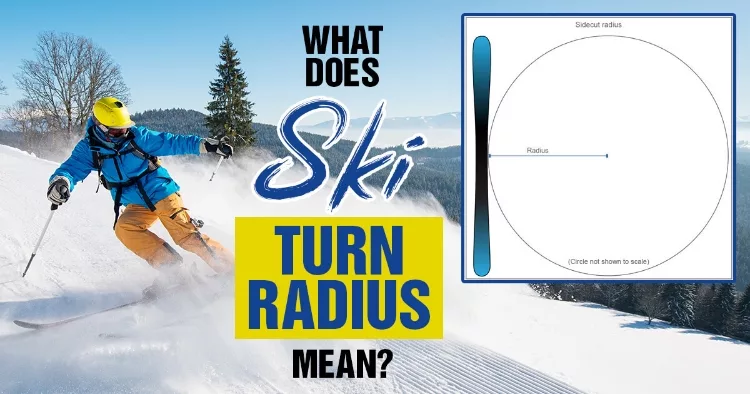What Does Ski Turn Radius Mean?
by Frank V. Persall
When you initially get into skiing, you will likely be familiar with the fact that you are going to have to purchase quite a bit of gear. But the most important gear is your skis, after all, you can’t ski without them. But choosing the right pair of skis isn’t as simple as going into the sports store and grabbing anything. You need to consider the ski radius; but what does ski radius mean?
Ski radius, which is commonly referred to as the turn radius is, in the most simple terms, the shape of the ski. This will vary according to the waist, tip, and tail. If a ski’s waist width is smaller when compared to the tip and tail width, this means that the turning radius will be shorter and the ski sidecut deeper.
Knowing this, there are still many things that you need to keep in mind when choosing a ski turn radius. In this guide, we will show you everything you need to consider to make choosing the right pair of skis much simpler.
Contents

Why Is A Ski Turn Radius Important?
When you buy a set of skis, you will need to consider the turn radius. This is important because it will determine how quickly the skis will turn and how stable they are when moving at higher speeds.
When you have a deeper ski sidecut with a short turn radius, this will make turning much quicker. Conversely, skis with a long turn radius and a less prominent sidecut will turn more slowly but will offer greater stability when you are skiing at higher speeds.
How Do I Choose A Ski Radius?
When you buy your first pair of skis, you may feel a little intimidated, but there is no need to be. Once you understand how a turn radius works with your skiing style, it will soon become second nature to choose the right pair.
Turn Radius & Dimensions
The turn radius refers to the overall shape of the ski and this is calculated by looking at the width of the waist, tip, and tail of the ski. For the most part, you will see that the measurements are given in meters. The shape of the ski is called the sidecut and in most modern skis the waist width is generally narrower than the tail and tip.
If you wanted to get technical, we could look at this from a mathematical perspective. When we talk about radius in math, we are referring to the distance from the middle point of a circle out to any point around its edge. In the case of skis, the sidecut can be considered the circle and when the radius is bigger, this means that the circle will be bigger; conversely, if you have a smaller circle, you end up with a smaller radius.
This may still sound a little confusing but in short, if you have a ski that is narrower at the waist but its widest point is at the tip, this will be better for making tight turns. On the contrary, skis with a narrower tail and tip are much better suited to a long turn. Below is a table that details the correct turn radius for the type of ski you are using.
| Type Of Skis | Turn Type | Turn Radius |
|---|---|---|
| Powder skis, carving skis, mountain skis | Short turns | Up to 16m |
| Pipe skis, park skis, all-mountain skis | Medium turns | 17 - 22m |
| Big mountain and powder ski | Long turns | More than 22m |
Camber & Rocker
When you lay a ski on the ground, you will notice that the center of the ski doesn’t touch it; rather the contact points are at either end. This is known as the camber and when we look at the area between these two contact points, this shows us which parts of the ski will make contact with the snow as you turn.
If you are going to successfully enter into a turn, the ski will need to be weighted but as well as this, it is essential that the ski has a degree of rising at the tail and tip; this is known as the rocker. The rocker allows the ski to sit slightly above deep snow making it easier to initiate the turn. If you are going to be skiing in deeper snow, a more pronounced rocker is recommended.
Sidecut & Underfoot Width
When you are looking at the turn radius of a ski, you will see a variety of figures and this can look a little confusing. But it is relatively simple once you wrap your head around it. For example, the Rossignol 16Ti has the following dimensions listed: 124-74-104 and these numbers each refer to a different dimension.
One of the most important dimensions to consider is the waist width which is sometimes called the underfoot width of the ski. Depending on the type of terrain you will be skiing on, you might need a specific underfoot. As a general rule, anything below 95mm is designed for skiing on the piste whereas skis with a waist over 110mm are better suited to big mountains and powder snow.
Additionally, you will want to think about the sidecut width. In older skis, the sidecut may have been as short as 6-7mm. However, most modern skis have a vastly more prominent sidecut that could be as wide as 20mm. The more pronounced the sidecut, the larger the completed circle from it would be, and as we have learned, this will affect the turn radius of the ski.
Summary
Buying a set of skis is no mean feat, there is a lot to consider but one of the most important factors is to look at the turn radius. The turn radius refers to the distance a ski will turn according to the sidecut. While this may all sound a little complicated, it’s usually worked out for you when buying skis and all you need to know is the ideal turn radius for the type of skiing you take part in.
If you are looking to try a new type of skiing or want more helpful buying tips, why not take a look at our skiing pages for more information.
Related Posts:
Which Mistakes Should A Newbie Skier Avoid
 |
 |
 |
 |

About Frank V. Persall
Frank is originally from the UK, but he has a passion for skiing that knows no bounds. He has made it his life's mission to visit the best ski resorts across the USA and the World. Frank loves spending time with his wife and three children on ski slopes, as they all share his love for the activity.
Thoughts on "What Does Ski Turn Radius Mean?"
 |
 |
 |
 |
You can get FREE Gifts. Or latest free skiing books here.
Disable Ad block to reveal all the info. Once done, hit a button below
 |
 |
 |
 |